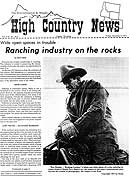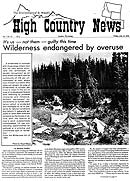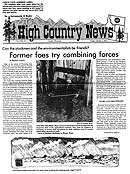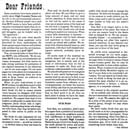One thing is certain: High Country News founder Tom Bell wasn’t afraid of poking a finger in someone’s chest. He openly criticized Wyoming’s ranchers and industry and the politicians that looked after them. The state’s pro-development governor, Stanley K. Hathaway, was a frequent target, as were a pair of Casper-area ranchers who shot and poisoned hundreds of eagles. Bell stirred up controversy and many subscribed just to hear what this fierce advocate of the West’s land and wildlife had to say.
Bell’s young successors, Joan Nice and Bruce Hamilton (see The Crusade Continues), took a different approach when handed the paper’s reins in 1974. “If we couldn’t be as personable, inspiring and wise,” Nice wrote in an essay in the Sept. 25, 1989 issue celebrating High Country News‘ 20th anniversary, “we’d be thorough and fair. We’d put out a newsy, more objective publication. Tom’s no-hold’s barred advocacy had made enemies as well as friends. We’d try to reach a broader audience, to become a trusted, if not so provocative, source of information about the Rocky Mountain West.”
Amidst the news about strip-mining, coal leasing and timber sales, Nice, Hamilton and their small staff reported stories that stirred controversy among environmentalists. They wrote about the decline of ranching in the West; the problems wild horses had wrought on fragile rangeland; whether the holy grail of land protection – wilderness – brought more threats from hikers and backpackers to the places it was meant to protect; and the growing trend among national environmental groups to reach out to farmers and ranchers and find common ground.
Some readers worried that High Country News was revealing too much about environmentalists’ strategies and struggles that could only be useful to ‘the opposition’. The editorial staff responded: “We do consider HCN to be an environmental advocacy newspaper, but that means we take strong positions for protection of our region’s resources in our editorials – not in our news pages. On our news pages we write about environmental issues, but, recognizing there are more sides to those issues, we endeavor to present all of them.”
To be sure, the paper continued to make enemies during Nice and Hamilton’s tenure. When President Gerald Ford tapped Wyoming’s Governor Hathaway as Secretary of Interior, High Country News exposed his dismal environmental record. The national press jumped on the story and found High Country News to be one of their best sources. One evening, while Hamilton was talking with a national reporter who had called him at home about Hathaway’s environmental shortcomings, an unidentified neighbor interrupted on their party telephone line: “Why don’t you guys just get out of the state?”
Wyoming was (and still is) a tough place to advocate for the environment, even for someone like Bell who was steeped in the rural culture he so often railed against. And for Nice and Hamilton, from the ‘outside’, it was even tougher. “I remember looking out the window of my Lander-bound car, agog at Wyoming’s spaciousness, its vast snowfields in May, and the orangish fur and space-creature eyes of a large ungulate I had never seen before,” wrote Nice. “Bruce, a wildlife major in college, knew it was a pronghorn antelope.”
If it wasn’t for the close-knit relationship between readers and High Country News, Bell and his early successors may have been consumed by the onerous task of building the institution. But in the tradition of a neighborly barn-raising, readers pitched in – they stuffed envelopes, sent contributions, provided photography and artwork for free, paid for ads touting High Country News in their local papers and bought subscriptions for school classes. And always their letters provided a lively debate and connection across a vast region. As a result of this reader loyalty and engagement, High Country News is deeply rooted in the West and continues to surprise, provoke and poke fingers in chests.
Stay tuned for the next post – about what really fired-up the letter writing.






